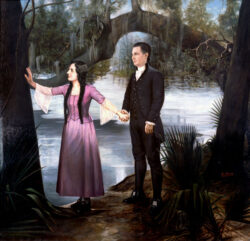Alexandre Alaux
Alexandre Alaux, born in France in 1851, came to Louisiana at the age of six. After studying in Europe, Alaux returned to Louisiana, where he painted with his children until his death in 1932.

Courtesy of Louisiana State Museum
Evangeline. Alaux, Alexander (artist)
Torn in Commercy, France, in 1851, Alexandre Alaux immigrated to New York City as a child and his family settled in New Orleans in 1855. Alaux studied with Francisco Bernard in New Orleans, learning the precise, highly finished, photographic style of painting popular in post-Civil War Louisiana. He also studied in New Orleans with scenic painters Ernest Ciciri and Eugene Philastre. Alaux was a progeny, and in 1869 won four silver medals at an exhibition held at the New Orleans Fairgrounds.
Like many artists in the U.S. following the Civil War, Alaux sought instruction in Europe. He earned degree from the Academie Royale des Beaux Arts in Brussels, taking “laurel crown and first prizes” in anatomy and archaeology – suggestive of Alaux’s persistent interest in history painting. King Leopold II awarded Alaux a gold medal for his oil painting Mississippi River by Moonlight, described in the exhibition catalogue as painted from memory. Alaux remained in Belgium for some time, and was appointed a professor at the Cours Sainte Marguerite. He married and had two children, returning to New Orleans in 1899. A mature, highly accomplished artist by this point, Alaux focused on miniatures, landscapes, portraits, and historical paintings. He also painted still lifes along with marine, mythological and religious scenes. He was an art teacher and offered services as a restorer. Alaux was much in demand for copies of earlier portraits for private, corporate and institutional clients, such as Jose Salazar’s Don Andres Almonester y Roxas (on view at the Louisiana State Museum). He concentrated on increasingly ambitious historical, religious, and literary tableaux later in life, such as Napoleon Bonaparte (ca. 1900), The Founding of New Orleans (ca. 1905), and Evangeline (1929), all now in the collection of the Louisiana State Museum.
Alaux’s son, Louis S. Albert, was also an artist. He drowned in Lake Pontchartrain in 1904 when the steamer New Camellia sank. Afterward, Alaux found among his son’s possessions a sketch of shipwrecked man clinging to a rock, appealing to the Virgin Mary holding the baby Jesus with outstretched arms. Below were scrawled the words “My God, help me,” supposedly his son’s last words heard by passengers aboard the steamship New Camellia. Heartbroken, Alaux used this sketch as the basis of a large oil painting entitled Our Lady of the Lake, on view at Our Lady of the Lake Church in Mandeville, Louisiana.
Later in life, Alaux was assisted by his two daughters: Marie Ferdinand, also an artist, and Louisa, who helped with historical research. Alaux was conservative and deeply religious, as suggested by a 1929 article in the Times-Picayune:
M. Alaux and his daughters are artists. They rarely go out except to church or to make quiet visits to intimate friends in the neighborhood and if you asked about a Bohemian salon they would look puzzled and tell you that they came from Belgium, not Bohemia.
Although born in France, Alaux’s heritage appears to have been Belgian, supported by his decision to study in Brussels. He was successful and well-respected in New Orleans, widely regarded as a prodigious, skillful, and learned artist. Alaux is best remembered today for his many public commissions. He is also celebrated –as he was during his lifetime – for the delicate miniatures painted in the style and with the attention to craft of his eighteenth-century forebears.
